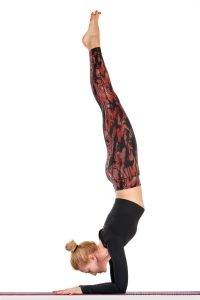Ashtanga Vinyasa Yoga (part 1)
 What is Ashtanga Vinyasa Yoga? P49A6399
What is Ashtanga Vinyasa Yoga? P49A6399
Ashtanga Vinyasa Yoga is a dynamic practice, which includes sequences of asanas, interconnected by sets of movements – vinyasas, and performed together with Ujayi-pranayama (a certain way of breathing), Bandhas (energy locks) and Drishti (focusing on certain points). During the practice, Dhyana (meditative state of consciousness) is preserved.
When synchronizing movement with breathing like ujayi and applying the energy locks mula bandha, uddiyana bandha during the asanas, a strong internal heat arises in the body, causing profuse perspiration. Thus, the process of cleansing and rejuvenation of muscles and internal organs occurs, toxins are removed from the body. As a result, the practitioner feels strength and lightness in the body. Vinyasa balances breathing and provides uninterrupted blood circulation throughout the body. Breathing becomes rhythmic, the body is strong, and the mind is calm.
Ashtanga Yoga includes six series:
The first series is called Yoga Chikitsa – Yoga Therapy. It helps to heal the body, make it strong, flexible and resilient.
The second series – Nadi Shodhana – works with the nervous system
The third series is divided into 4 advanced levels: Sthira Bhaga A, B, C, D. To practice the third series requires a year of practice, great strength and flexibility, breathing control, bandh, and mental stability.
Origin and history
Ashtanga Vinyasa Yoga is one of the yoga systems that Vamana Rishi described in the ancient text “Yoga of the Corunt”. Sri T. Krishnamacharya received this text from his Guru Rama Mohan Brahmachari. After studying the manuscript, Sri Krishnamacharya and his disciple Pattabhi Jois restored six sequences, which are now called Ashtanga Vinyasa Yoga. Sri Krishnamacharya incorporated new information into his vast knowledge of various yoga techniques, but persuaded Pattabhi Jois to devote himself exclusively to the practice and dissemination of discovered sequences. Sri K. Pattabhi Jois founded the Ashtanga Yoga Research Institute (AYRI) in Mysore (Karnataka, India). After the death of Guruji Sri K. Pattabhi Jois, May 18, 2009, the guardians of the tradition are his daughter Saraswati Rangaswami and grandson of Rangaswami Sharat Joyce. The Ashtanga Yoga Research Institute has now been renamed the Sri K. Pattabhi Jois Institute of Ashtanga Yoga.
According to one version, the text of Vaman Rishi of “Yoga Corund” was created 1000-2000 years ago. The first part of the text described the asanas and principles of yoga practice, and the second contained comments on the Yoga Sutras by Patanjali. Asanas were presented in a certain sequence, and they should be performed necessarily in combination with special breathing, vinyasas, bandhas and drishti. The practice presented in the book contained all eight stages of yoga, which are described in the “Sutras” of Patanjali, and therefore it was called “Ashtanga Yoga”.
The most famous postulate from the Vamana treatise was the words “Oh yogi! Do not do asana without vinyasa. ” According to Rishi, vinyasa generates internal heat, starts the processes of purification of internal organs and the nervous system, puts the mind in a meditative state.
Unfortunately, the manuscript of Vaman Rishi of “Yoga Corund” has not been preserved.
Ashtanga Yoga Fundamentals
The key elements of Ashtanga Yoga are:
-Fixed series (sequences) of asanas.
Each series has a maximum impact only in its integrity.
-Vinyasa – the principle of synchronization of movement and breathing, on which the whole Ashtanga Yoga system is built.
– Ujaya breathing, or breathing with sound, is a specific breathing method used throughout practice.
-Drishti – concentration of attention at a certain point.
Bandhi – energy locks. In Ashtanga yoga, Mula Bandha (root castle) and Uddiyana Bandha (castle of the abdominal region) are used. By controlling the muscles of the pelvic floor and lower abdomen, we learn how to manipulate the energy in the body, hold and accumulate it.
!!! Without the implementation of these principles, Ashtanga yoga loses its essence and turns into a kind of fitness, so it is very important to pay close attention to them from the very beginning.



